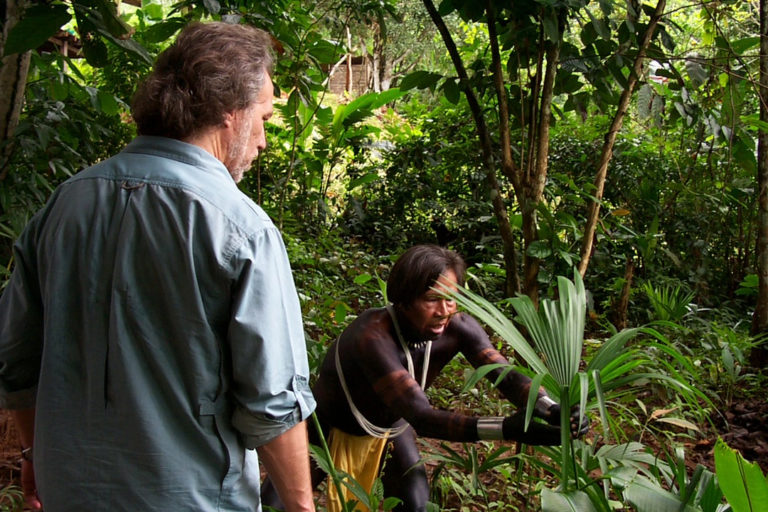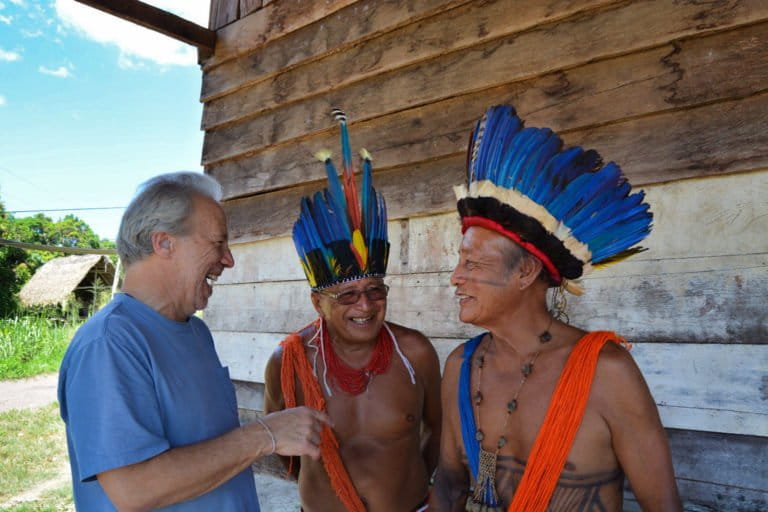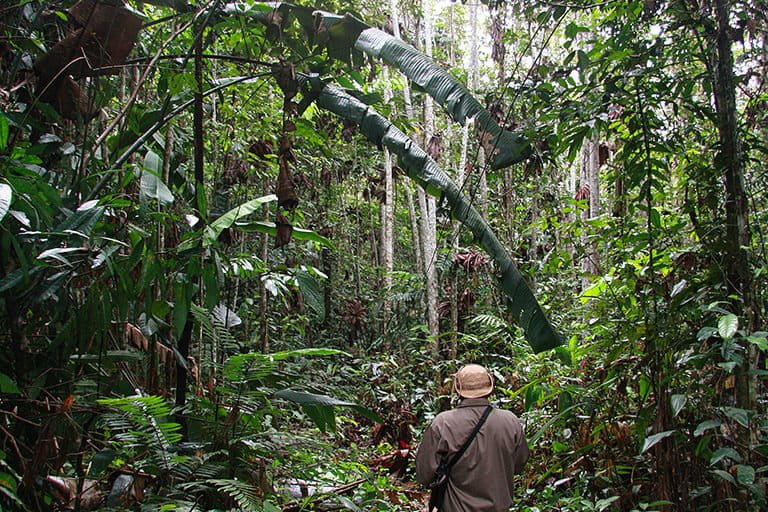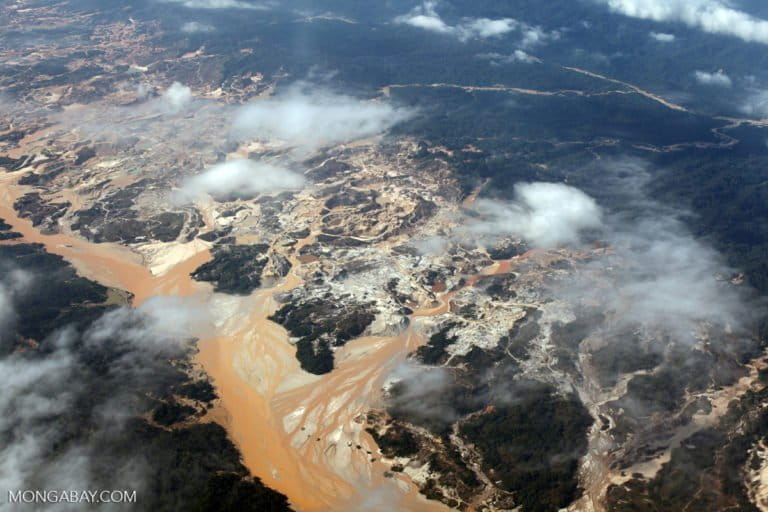
- As a best-selling author, the co-founder of the award-winning Amazon Conservation Team, and an acclaimed public speaker, Mark Plotkin is one of the world’s most prominent rainforest ethnobotanists and conservationists.
- His experiences in Amazonian communities led Plotkin, along with Costa Rican conservationist Liliana Madrigal, to establish the Amazon Conservation Team (ACT) in 1995. ACT took a distinctly different approach than most Western conservation groups at the time: It placed Indigenous communities at the center of its strategy.
- ACT’s approach has since been widely adopted by other organizations, and its philosophy as a whole is now more relevant than ever as the conservation sector wrestles with its colonial roots.
- Plotkin spoke of his work, trends in conservation, and a range of other topics in a January 2022 interview with Mongabay founder Rhett A. Butler.
As a best-selling author, the co-founder of the award-winning Amazon Conservation Team, and an acclaimed public speaker, Mark Plotkin is one of the world’s most prominent rainforest ethnobotanists and conservationists. Plotkin has worked closely with Indigenous communities–including traditional healers or shamans–since the 1980s, first as an academic, then as a member of a large conservation organization.
His experiences in Amazonian communities led Plotkin, along with Costa Rican conservationist Liliana Madrigal, to establish the Amazon Conservation Team (ACT) in 1995. ACT took a distinctly different approach than most Western conservation groups at the time: It placed Indigenous communities at the center of its strategy, working in deep and sustained partnerships with Indigenous elders and leaders to strengthen recognition of their rights through a combination of traditional knowledge and mapping technologies. These efforts have resulted in vast swathes of Indigenous territories across rainforests in Colombia, Suriname, and Brazil securing better protection, both functionally and legally. They have also helped elevate the public’s consciousness about the value and importance of traditional Indigenous knowledge.

ACT’s approach has since been widely adopted by other organizations, and its philosophy as a whole is now more relevant than ever as the conservation sector wrestles with its colonial roots and the associated issues around discrimination, inclusion, and representation. Put another way, ACT’s longtime model has gone from being seen as fringe to being mainstream.
Plotkin welcomes these developments, but cautions that it will take more than lip-service and money to drive meaningful shifts in how conservation groups work with Indigenous communities.
“Claiming you are going to do something difficult and then carrying it out successfully are not the same thing,” Plotkin told Mongabay during a January 2022 interview. “In my experience, partnering effectively with tribal colleagues and communities does not happen on a western timeline and is certainly not expedited by simply throwing lots of money at the process.”

Plotkin has been working to broaden public interest in Indigenous cultures and knowledge through a variety of platforms, from books to speeches to films, as a way to create a stronger constituency for Indigenous-led conservation. Last year he launched a podcast, “Plants of the Gods: Hallucinogens, Healing, Culture and Conservation”, to reach new audiences with this message.
Plotkin says that the podcast’s emphasis on medicinal plants, especially hallucinogenic plants, serves a purpose.
“I believe that hallucinogens and shamanism represent some of the most important ‘connective tissue’ between tropical nature and human well-being,” Plotkin told Mongabay.

As with his books, Plotkin leverages his storytelling abilities to engage his audience. These skills, he says, are critical to maximizing your effectiveness, whether that’s as a conservationist or something else.
“I have spent much of my career working with Indigenous peoples where… storytelling represents an essential craft,” he said.
“Our industrialized society and our educational system have long undervalued the importance of telling an effective story. Whether you are a prosecutor trying to convince a jury, or a fundraiser trying to convince a donor, or a conservationist trying to convince a government official, you must be able to convey the information in a clear and compelling manner.”
Plotkin spoke of his work, trends in conservation, and a range of other topics in a January 2022 exchange with Mongabay founder Rhett A. Butler.

AN INTERVIEW WITH MARK PLOTKIN
Mongabay: You launched a very popular podcast last year. As a biologist and a successful author, what moved you to start podcasting?
Mark Plotkin: When I was a kid, there were only three channels of television, meaning an important message that appeared on any one of these channels would be seen by tens of millions of people. Such is no longer the case. If you want to disseminate a message widely, you have to work in a variety of media. I launched “Plants of the Gods: Hallucinogens, Healing, Culture and Conservation” with the intent of reaching a new and broad audience beyond just the folks who visit the Amazon Conservation Team website or have read my books.
Mongabay: Why the focus on hallucinogens and shamanism?
Mark Plotkin: First and foremost, because I am an ethnobotanist, and these are topics that I have found endlessly fascinating since I first wandered into a night school class taught my mentor Richard Schultes, the so-called “Father of Ethnobotany,” in September of 1974.
Secondly, because I believe that hallucinogens and shamanism represent some of the most important “connective tissue” between tropical nature and human well-being.

Thirdly, because of timing: Every week brings more news about how tropical hallucinogens like psilocybin and ayahuasca (both covered in episodes of “Plants of the Gods”) offer new hope in the treatment—and, sometimes, the cure—of intractable mental ailments ranging from depression to addiction.
Mongabay: Is this why ayahuasca tourism seems so out of control in places like Peru?
Mark Plotkin: This question brings to mind more than one cliché: “It is the best of times; it is the worst of times.” “When God wants to punish you, she answers your prayers.” “When it rains, it pours.”
Look, every biologist as far back as Linnaeus noted the expertise of Indigenous peoples regarding use of local flora and fauna. And most ethnobiologists as far back as Schultes in the late 1930s observed that these cultures used these species to heal in ways we could not understand, that – in the cases of hallucinogenic plants and fungi – shamans were employing psychoactive plants and fungi as biological scalpels to diagnose, analyze, treat and sometimes cure ailments that our own physicians or psychiatrists could not.
It therefore comes as no surprise that people whose medical, spiritual and/or emotional needs are not being met by western medicine or organized religion are traveling to places like Iquitos in the Peruvian Amazon to be treated by “indigenous shamans” – some of whom are not Indigenous and many of whom are not shamans.

The combination of remote areas, linguistic challenges, emotionally unstable people, altered states and money is a combustible one, and resulted in many problems and some fatalities. In my pal Michael Pollan’s book, “How to Change Your Mind: What the New Science of Psychedelics Teaches Us About Consciousness, Dying, Addiction, Depression, and Transcendence,” he makes a compelling case as to how and why emotionally fragile people are the ones most at risk in these ceremonies purchased via websites.
Of course, there is a win-win scenario here in which shamanism remains an honored profession, Indigenous people are compensated fairly for their healing knowledge and practices, the rainforest is better protected and cherished, and sick people are cured. Yet achieving these goals have proven more difficult than many had anticipated.
Mongabay: Which brings to mind my next question: The Amazon Conservation Team has put Indigenous communities at the center of its work since inception. Now the conservation sector as a whole is putting much more emphasis on the role Indigenous peoples play in achieving conservation and climate objectives. In your view, what has driven this shift?
Mark Plotkin: It is all too easy to say that the only news that is coming out of the environment in general – and the rainforest in particular – is bad. That people in general and large conservation organizations are now realizing the central role local societies must be empowered to assume is highly encouraging. That the Indigenous peoples themselves are pointing out that they are the best stewards of their ancestral ecosystems is likewise long overdue and to be celebrated.
Nonetheless, claiming you are going to do something difficult and then carrying it out successfully are not the same thing. In my experience, partnering effectively with tribal colleagues and communities does not happen on a western timeline and is certainly not expedited by simply throwing lots of money at the process. For example, for almost four decades, I have been working with the great shaman Amasina – who has been interviewed by Mongabay – and he is still showing me new treatments. Trying to learn information like this in a hurry would have failed.


Another personal example: about five years ago, I was invited (as an observer) to attend a gathering of Indigenous leaders in northeastern Brazil. On the first afternoon, I was approached by Captain Aretina of the Tiriyo people. He said, “I have not seen you in over 30 years. You were my father’s friend. When I heard you were going to be here, I traveled five days from my village to attend. May I give you a hug?” And we embraced, warmly and tearfully.
You cannot create this type of bond when you land at a small rainforest airstrip, tell the pilot to wait for you, have a brief meeting with the village chief, offer him lots of money and then get back on the plane and fly off.
Mongabay: The Amazon Conservation Team’s work in Colombia has significantly expanded over the past decade. What is the impact you’re most proud about in Colombia?
Mark Plotkin: The Amazon Conservation Team just celebrated its 25th Anniversary and Colombia was our first program and remains our largest. The accomplishments there are legion: Gaining title to more than two million acres (an area larger than Yellowstone) for the Indigenous peoples themselves, creation of the first Indigenous women’s reserve (“Mamakunapa”) in the northwest Amazon (with the assistance of my friend Tim Ferriss), and helping craft and pass legislation to protect uncontacted tribes and their ancestral rainforests.
One of the most meaningful achievements for me personally involves the expansion of Chiribiquete National Park where Schultes worked and collected. So stunned was he by this spectacular landscape after he first visited in 1943 that he began lobbying to have the region declared a protected area as soon as he returned to the capital city of Bogotá. In close collaboration with Colombian colleagues in both academia and government, this first came to fruition in 1989.
During the past decade, under the leadership of Northwest Amazon Program Director Carolina Gil and ACT co-founder Liliana Madrigal, we have partnered with local Colombians, (including Indigenous colleagues), to expand Chiribiquete to become the largest rainforest protect area in the Amazon (if not the world). At more than 17,000 square miles, it is twice the size of Massachusetts and protects a multitude of flora and fauna, the worlds’ largest assemblage of Indigenous painting, and at least three uncontacted tribes.

Mongabay: And what about beyond Colombia?
Of course, there are other signature projects elsewhere. In the northeast Amazon, we have successfully partnered with local Indigenous peoples to help them bring no fewer than five non-timber products to market, with more in the pipeline. As far as I know, our Indigenous Ranger Program in the same region is the one of the first and longest running programs of this type in lowland South America. And our Shamans and Apprentices Program – facilitating the transfer of intragenerational healing wisdom within the tribe has been similarly effective.
And mapping: We are extremely proud of the fact that ACT – under the leadership of our ace cartographer Brian Hettler – has partnered with over 90 Indigenous groups to train them to map their own lands.
Furthermore, we have created highly innovative “Story Maps” for a variety of purposes. My two favorites are “The Life and Times of Richard Schultes” and “Lands of Freedom focusing on the oral history and history of the Matawai Maroons of Suriname, a landmark in documenting the African American diaspora.
Mongabay: Returning to the subject of Colombia, despite relatively progressive policies around Indigenous rights and conservation, Colombia’s deforestation rate has been climbing. What do you see as the key elements to reversing this trend?
Mark Plotkin: Apparently, the Presidents of both Colombia and Costa Rica were hailed as heroes at the recent COP meetings, based largely on programs and projects largely enacted by predecessors.

We need both the carrot and the stick to move forward in the sense that positive moves need to be celebrated while destructive moves are punished by economic responses, not just in the tropics but here in the industrialized world as well.
The concentration of wealth also needs to be called out: That more and more of the world’s wealth is the hands of the few, especially those few who have little connection to nature, bodes ill for the future. It is encouraging to see more billionaires writing checks for progressive causes but — with some very noteworthy exceptions — they are not giving their support to the most effective grassroots organizations, despite a lot of blather about “impact investing.”
The bottom line: We need to more effectively celebrate or criticize politicians and businesspeople for their actions. We also need to make sure much more training, opportunity and support are reaching communities at the grassroots level. And we need to do what we can to reorient our society and our economy to stop glorifying profits at all costs and promoting short-term gratification planning, thinking and operations which is fouling our global nest at an ever more frantic pace.
Mongabay: Beyond what you’ve mentioned so far, what do you see as the biggest gaps in the conservation sector? What is holding conservation back from having greater impact?
Mark Plotkin: One need is better analysis: What is the cost of pouring mercury into the Amazon in terms of human suffering and increased cancers? Of course, presenting the cost-benefit equation alone as a simple solution is far too reductionist. Throughout the course of human prehistory (e.g., the overhunting and extinction of animals as varied as the American mammoth and the Steller’s sea cow) and history (deforestation of the Mediterranean countries, DDT as a pesticide, voting against one’s economic self-interest, etc.), people have always carried out self-destructive practices.

Yet better explanation of costs and benefits, better elucidation of the spiritual components of environmental stewardship and better prosecution of environmental destroyers would bode well for the future. Many environmentalists forget: It was evangelicals who spoke in support of and fought to protect the Endangered Species Act when it was threatened in the 1980s. Better bridge-building in our ever more politically polarized world in the U.S. could conceivably bring many benefits.
Mongabay: Do you think the pandemic will teach us anything about how to do conservation better?
Mark Plotkin: I penned an editorial for the Los Angeles Review of Books, titled “Conservation and Coronavirus,” that described the link between the rise of the novel coronavirus and the abuse of nature in general and the wildlife trade in particular, and asserted that the best way to head off the next pandemic was to reset and rethink much of the unethical and needlessly cruel exploitation of Mother Nature, from deforestation to cramming animals into fetid cages. Many, many others have spoken to the same issues. Time will tell if there were lessons learned from the pandemic. In the short term, I am not seeing the changes necessary.
Mongabay: You’re the author of several acclaimed books, have appeared in numerous documentaries, and host a successful podcast. What would you tell younger colleagues about the importance of storytelling?
Mark Plotkin: I start with two advantages. First, I hail from New Orleans, where good storytelling is a highly celebrated practice. Not only is it a city where many great writers and storytellers were born, but even some of our most celebrated authors who weren’t raised there, like Twain and Faulkner, had their careers and abilities turbocharged by spending time in New Orleans. I have also spent much of the past four decades working with traditional storytellers in Indigenous cultures where being able to make a point through a tale well told is of paramount importance.
Secondly, I have spent much of my career working with Indigenous peoples where (once again) storytelling represents an essential craft.
The single best book I have every read about learning how to tell a story – whether it is while sitting around a campfire in the wilderness or composing a script for Netflix – is “The Writer’s Journey,” by Chris Vogler. The author explains Joseph Campbell’s “Hero’s Journey” through the prism of Hollywood films and explains why and how “The Wizard of Oz,” “Star Wars” and “Harry Potter” are the same basic story. Every storyteller should read this book!

Finally, I would say that our industrialized society and our educational system have long undervalued the importance of telling an effective story. Whether you are a prosecutor trying to convince a jury, or a fundraiser trying to convince a donor, or a conservationist trying to convince a government official, you must be able to convey the information in a clear and compelling manner.
Mongabay: What advice would you give to a young person considering a career in conservation?
Mark Plotkin: It is very easy for everyone – not just young people – to be discouraged by the global environmental situation: deforestation, wildfires, pollution, climate change, etc. – the list is long and seemingly endless. However, nothing is worse than doing nothing because you can’t do everything.
Monumental change IS possible, although you do not often see it featured in the media. Just look at Mongabay: even with the all the heartbreaking stories, there are always accounts of new ideas, initiatives, and successes. I concluded my most recent book as follows: “When I was growing up in the 1950’s and 1960’s, people habitually threw litter out their car windows, smoked cigarettes in offices and on airplanes, shunned seatbelts and assumed the Berlin Wall would never come down. With enough changed minds come changed policies and realities.”

So to modify a much quoted aphorism: be and create the change to want to see. The shamans with whom I have had the honor and privilege to learn from for almost four decades insist on the interconnectedness of all things, be it deforestation or racism or elephant poaching or poverty or climate change. I certainly believe the world needs more ethnobotanists and other boundary walkers who can straddle different cultures and belief systems, but I also know that we need more lawyers and politicians and spiritual leaders and politicians and artists and businesspeople to join the cause. Environmental justice and stewardship are way too important to be left solely to environmentalists!
Ethnobotanist Mark Plotkin: Indigenous knowledge serves as a ‘connective tissue’ between nature and human well-being
Source: Trends News


0 Comments